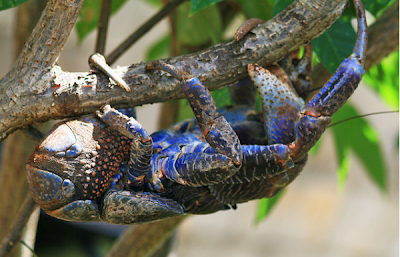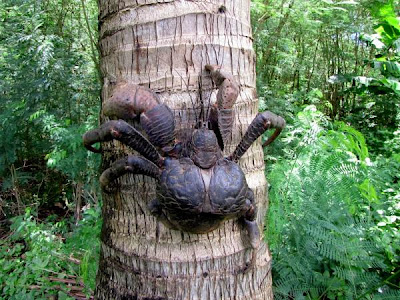 |
| Blue Coconut Crab |
Coconut Crab:
The coconut crab, Birgus latro, is a
species of terrestrial hermit crab,
also known as the robber crab or palm
thief. It is the largest land-living arthropod on the world, and is probably at the upper size limit or terrestrial animal with exoskeletons in recent Earth atmosphere, with a
weight of up to 4.1 kg (9.0 lb). It can grow up to 1 metre
(3 ft) in length from leg to leg. It is found on islands across the Indian Ocean and parts of the Pacific Ocean as far east as the Gambier Islands, mirroring the
distribution of the cocnut palm;
it has been extirpated from
most areas with a significant human population, including mainland Australia and Madagascar.
 |
| Black Coconut Crab |
The coconut crab is the only species of
the genus Birgus,
and is related to the terrestrial hermit
crab of the genus Coenobita.
It shows a number of adaptations to
life on land. Like hermit crabs, juvenile coconut crabs use empty gastropod shells for protection,
but the adults develop a tough exoskeleton on their abdomen and stop carrying a
shell. Coconut crabs have organs known as "branchiostegal lungs", which are used instead of the
vestigial gills for
breathing. They cannot swim, and will drown if immersed in water for long. They
have developed an acute sense of smell, which has developed convergently with that of insects, and which they use to find
potential food sources. Mating occurs on dry land, but the females migrate to
the sea to release their fertilised eggs as they hatch. The larvae are
planktonic for 3–4 weeks, before
settling to the sea floor and entering a gastropod shell. Physical maturity is reached
after about 5 years, and the total lifespan may be over 60 years. Adult coconut crabs feed on
fruits, nuts, seeds, and the pith of
fallen trees, but will eat carrion and
other organic matter opportunistically. The species is popularly associated
with the coconut, and has been
widely reported to climb trees to pick coconuts, which it then opens to eat the
flesh. While coconut crabs can climb trees, and can eventually open a coconut
collectively, coconuts are not a significant part of their diet. Coconut crabs
are hunted wherever they come into contact with people, and are subject to
legal protection in some areas.
 |
| Red Coconut Crab |
Habitat:
Coconut piles provide food for young crabs as well as
protection. Studies suggest that the larger crabs remain close to
their burrows because they are already positioned in the best areas, where as
small crabs will venture across an island in search of food or a better place
to hide. As these animals grow in size, they depart from the safety of their
existing burrow to find a larger place to live. Since coconut crabs are not
depedent on snail shells for a home as the progress into adulthood, they are
capable of growing to extremely large sizes. Coconut crabs are the largest
terrestrial arthropods currently living on earth. Therefore, it is not
surprising that the largest crabs, which are also the most dominant, live in
the nicest burrows.
 |
| Red Coconut Crab |
Ideal burowing areas are those found in sandy soil because
it is easier for a crab to dig. That is why smaller crabs often live closer to
the coral edges of the island, where it is more difficult to build a nice
burrow. The juvenile coconut crab diet differs from that of the adults,
partly because of where they reside. The juveniles generally live under coconut
piles or dense vegetation which provide the leaf and plant litter that they
feed on. The adult coconut crabs are omnivores. They forage by night for
fruits, rotting leaves, coconuts, and dead or injured animals, as well as other
coconut crabs. Originally, coconut crabs were found on islands
throughout most of the Indo-Pacific Region. The crab's slow rate of growth as
well as late sexual maturity (six to eight years of age), has made them very
susceptible to over exploitation. Recently they have become more rare because
are a delicacy and have been captured at a quicker pace than they can
reproduce. Coconut crab populations on Palmyra are high relative to other
islands that they inhabit because the human threat is nonexistent.




No comments:
Post a Comment